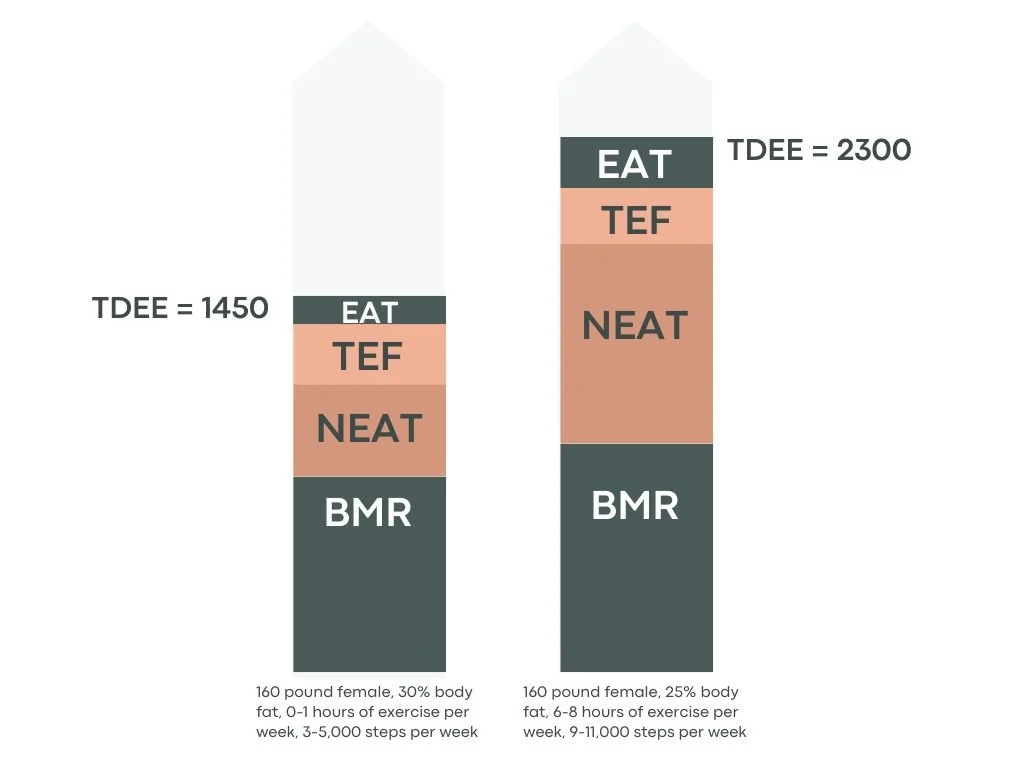What are calories?
When we are working on weight loss, it all comes down to calories. A calories is a unit of measurement for energy—just like an inch measures length or a pound measures weight, a calorie measures the amount of energy in food and drink. Your body uses these calories to fuel everything it does, from keeping your heart beating to powering a workout.
What is metabolism?
Your metabolism is the system that manages and distributes these calories for different needs. It’s not just one thing happening in your body—it’s a collection of processes that work together to keep you alive and functioning. Let’s break it down.
Basal Metabolic Rate (BMR)
This is the largest component of metabolism for most people, usually equating to 60-70% of daily calorie use. BMR represents the energy your body needs to keep basic functions running while at rest, like breathing, circulating blood, regulating body temperature, and repairing cells. Factors like age, genetics, body size, and especially muscle mass affect your BMR.
Why Muscle Matters for Metabolism: muscle tissue is metabolically active, meaning it burns more calories at rest compared to fat tissue. While the difference per pound isn’t enormous, it adds up: more muscle increases your resting metabolic rate and makes your body more efficient at using calories.
Thermic Effect of Food (TEF)
Whenever you eat, your body spends energy digesting, absorbing, and metabolizing nutrients from your food. This is TEF, and it makes up about 10% of daily energy use. Not all foods require the same energy to process, however:
Protein has the highest TEF, about 20-30% of the calories in protein are burned off just during digestion.
Carbohydrates use about 5-10% of calories for digestion.
Fats use the least, only about 0-3% of calories from fat are used for digestion.
This means high protein foods not only help with muscle repair and satiety, but also slightly increase how many calories your body burns processing them.
Physical Activity
Physical activity is divided into two groups:
Exercise Activity Thermogenesis (EAT): planned, structured activity like lifting weights, running, cycling, or fitness classes. This can make up 10-20% of daily energy expenditure, depending on how active you are.
Non-Exercise Activity Thermogenesis (NEAT): all the movement that isn’t formal exercise—walking around at home or work, standing instead of sitting, doing chores, fidgeting, playing with your kids. NEAT can vary dramatically from person to person and can make a huge difference in calories burn. It can make up 15-50% of daily energy expenditure.
Why is NEAT so important? Because while you might spend 1 hour in the gym, you spend the other 15 waking hours of your day moving—or sitting. Small changes like standing more, walking after meals, or choosing the stairs over the elevator can add up to a meaningful calorie burn. Having a ‘step goal’ can contribute to more daily movement, someone getting 10,000 steps per day will burn more calories than someone getting 1,000 steps per day.
Total Daily Energy Expenditure (TDEE)
When you add up these components of metabolism you get your Total Daily Energy Expenditure. This number represents the total amount of calories your body burns in a day. TDEE is the foundation for understanding weight management: if you consistently eat more calories than your TDEE, your body stores the excess (often as fat). If you consistently eat fewer, your body taps into stored energy to make up the difference, leading to weight loss. Knowing the components of metabolism helps you see where you have the most influence—like increasing your NEAT, prioritizing protein, and building muscle—so you can create realistic, sustainable changes rather than chasing quick fixes.
References
Huth PJ, Fulgoni VL, Keast DR, Park K, Auestad N. Major food sources of calories, added sugars, and saturated fat and their contribution to essential nutrient intakes in the U.S. diet: data from the National Health and Nutrition Examination Survey (2003-2006). Nutr J. 2013 Aug 08;12:116. [PMC free article] [PubMed]
Zabriskie HA, Currier BS, Harty PS, Stecker RA, Jagim AR, Kerksick CM. Energy Status and Body Composition Across a Collegiate Women's Lacrosse Season. Nutrients. 2019 Feb 23;11(2) [PMC free article] [PubMed]
Patton K. Fueling and Recovery. Sports Med Arthrosc Rev. 2019 Mar;27(1):22-24. [PubMed]
Lagergren K, Lindam A, Lagergren J. Dietary proportions of carbohydrates, fat, and protein and risk of oesophageal cancer by histological type. PLoS One. 2013;8(1):e54913. [PMC free article] [PubMed]
Manchishi SM, Cui RJ, Zou XH, Cheng ZQ, Li BJ. Effect of caloric restriction on depression. J Cell Mol Med. 2018 May;22(5):2528-2535. [PMC free article] [PubMed]
Kim DW, Kang HC, Park JC, Kim HD. Benefits of the nonfasting ketogenic diet compared with the initial fasting ketogenic diet. Pediatrics. 2004 Dec;114(6):1627-30. [PubMed]
Longo VD, Fontana L. Calorie restriction and cancer prevention: metabolic and molecular mechanisms. Trends Pharmacol Sci. 2010 Feb;31(2):89-98. [PMC free article] [PubMed]
Secombe P, Harley S, Chapman M, Aromataris E. Feeding the critically ill obese patient: a systematic review protocol. JBI Database System Rev Implement Rep. 2015 Oct;13(10):95-109. [PubMed]
Wood LG. Diet, Obesity, and Asthma. Ann Am Thorac Soc. 2017 Nov;14(Supplement_5):S332-S338. [PubMed]
Tomiyama AJ, Mann T, Vinas D, Hunger JM, Dejager J, Taylor SE. Low calorie dieting increases cortisol. Psychosom Med. 2010 May;72(4):357-64. [PMC free article] [PubMed]
Hall KD, Bemis T, Brychta R, Chen KY, Courville A, Crayner EJ, Goodwin S, Guo J, Howard L, Knuth ND, Miller BV, Prado CM, Siervo M, Skarulis MC, Walter M, Walter PJ, Yannai L. Calorie for Calorie, Dietary Fat Restriction Results in More Body Fat Loss than Carbohydrate Restriction in People with Obesity. Cell Metab. 2015 Sep 01;22(3):427-36. [PMC free article] [PubMed]
Camacho S, Ruppel A. Is the calorie concept a real solution to the obesity epidemic? Glob Health Action. 2017;10(1):1289650. [PMC free article] [PubMed]
Poulose SM, Miller MG, Scott T, Shukitt-Hale B. Nutritional Factors Affecting Adult Neurogenesis and Cognitive Function. Adv Nutr. 2017 Nov;8(6):804-811. [PMC free article] [PubMed]
